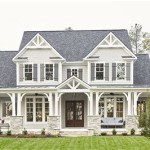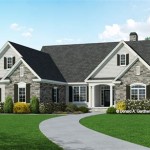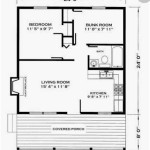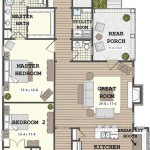New England House Floor Plans: A Guide to Classic Style and Practical Design
New England house floor plans embody a rich architectural tradition, rooted in practicality and charm. These plans have evolved over centuries, adapting to changing lifestyles and incorporating modern amenities while retaining their signature aesthetic. From the iconic Cape Cod to the more spacious Colonial, New England house floor plans offer a range of options for those seeking a timeless and comfortable home. This article explores the key features, variations, and enduring appeal of New England house plans.
Classic Features and Layouts
New England house plans are characterized by their symmetrical layouts, steep pitched roofs, dormers, and often, a central chimney. The focus is on creating a cozy and functional living space with a strong connection to the outdoors. Common features include:
- Front-Facing Entryways: The main entrance is typically positioned prominently on the facade, welcoming visitors and setting the stage for the home's interior.
- Central Hallways: Hallways serve as the heart of the home, connecting rooms and providing a sense of flow and organization.
- Formal Living and Dining Rooms: These spaces often feature elegant fireplaces, intricate moldings, and large windows, reflecting the emphasis on gracious living.
- Cozy Kitchens and Family Rooms: While formal spaces are important, New England homes also embrace the concept of comfortable gathering areas, making cooking and socializing enjoyable.
- Bedrooms on Upper Floors: The bedrooms are typically located on the second floor, ensuring privacy and quiet enjoyment.
The layout of a New England house plan is often influenced by its age and style. Older homes may feature smaller rooms and a more compact footprint, while newer designs incorporate open-concept layouts and larger living areas.
Popular New England House Plan Styles:
Within the broader umbrella of New England architecture, several distinct styles stand out. Each style has its own unique characteristics and design elements:
1. Cape Cod:
The Cape Cod style is perhaps the most iconic and instantly recognizable of New England house plans. These homes are characterized by their simple, symmetrical facades, steep pitched roofs, and often, a central chimney. The ground floor typically includes a living room, dining room, kitchen, and one or two bedrooms. Cape Cod homes are known for their cozy and inviting atmosphere and their ability to adapt to various site conditions.
2. Colonial:
Colonial homes are a bit more formal than Cape Cods, featuring elaborate details and often two or more stories. They typically have a central entrance with a portico or columns, multiple chimneys, and a symmetrical facade. Colonial floor plans prioritize spacious living areas and often include formal dining rooms, libraries, and a master suite with a private bathroom.
3. Farmhouse:
Farmhouse style homes in New England often showcase a more rustic aesthetic, with exposed beams, wide porches, and a connection to the surrounding landscape. They typically feature a simple layout with a focus on functionality and practicality. Farmhouse floor plans often prioritize open-plan spaces for family gatherings.
4. Victorian:
Victorian style homes are known for their elaborate details, intricate ornamentation, and wide variety of architectural elements. These homes often have multiple stories, with turrets, gables, and gingerbread trim. Victorian floor plans are typically complex and feature numerous rooms, including parlors, conservatories, and large bedrooms.
Each style offers distinct advantages depending on the homeowner's preferences and lifestyle. The Cape Cod is ideal for those seeking simplicity and affordability, while the Colonial provides a more formal and elegant setting. Farmhouse plans appeal to those who value rustic charm and connectivity to nature, and Victorian homes offer a luxurious and grand experience.
Considerations for Choosing a New England Floor Plan:
When selecting a New England house plan, several essential factors should be considered:
1. Lifestyle:
Consider the size and layout of the home to accommodate the needs of your family and activities. If you entertain frequently, a formal dining room may be essential. If you value privacy, a master suite with a private bathroom is a worthwhile investment.
2. Budget:
Develop a realistic budget for construction and understand the cost implications of different features, such as a large kitchen or a finished basement.
3. Location:
The lot size and site conditions will influence the suitability of different house plans. A narrow lot may require a more compact design, while a spacious lot allows for greater freedom in choosing a plan.
4. Climate:
New England's climate is known for its cold winters and hot summers. Consider features that promote energy efficiency, such as insulation, well-placed windows, and efficient heating and cooling systems.
By carefully considering these factors, you can ensure that your chosen New England house plan aligns with your needs, lifestyle, and preferences.
New England house plans offer a timeless blend of style and practicality. Whether you envision a charming Cape Cod, a stately Colonial, or a cozy farmhouse, these plans offer a wide range of options to create a home that reflects your individual taste and provides a comfortable and inviting space for generations to come.

50 Top New England House Plans And Northeast Style Designs

50 Top New England House Plans And Northeast Style Designs

Colonial Early New England Homes

New England Style Narrow Lot Plan 69089am Architectural Designs House Plans

Dutch Colonial House Plans Detailed Blueprints New England Home Historic American Homes

Elbring New England Style Home Homes Colonial House Plans Cape Cod

The New England Farmhouse Classic Colonial Homes

Shingle Style House Plans By Maine Coast Cottage Co Offering Blueprints Reminiscent Of The New England Bar Harbor Nantucket Kennebunkport Martha S Vineyard Cape Cod

Cape Early New England Homes

New England Floor Plans Ranch Two Story Cape The Home








